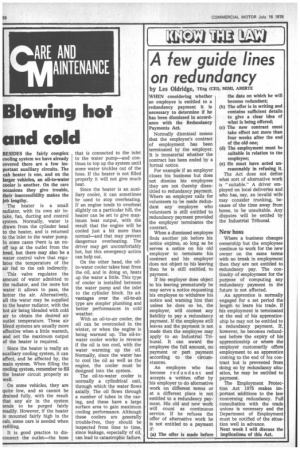Ciii ‘REANTIENANCE
Page 58

If you've noticed an error in this article please click here to report it so we can fix it.
Blowing hot and cold
BESIDES the fairly complex cooling system we have already covered there are a few im portant auxiliary circuits. The cab heater is one, and on the larger vehicles, an oil-to-water cooler is another. On the rare occasions they give trouble, their inaccessibility makes the job lengthy.
The heater is a small radiator, with its own air intake, fan, ducting and control system. Normally, water is drawn from the cylinder head to the heater, and is returned to the inlet to the water pump. In some cases there is an onoff tap at the outlet from the head, but there may also be a water control valve that regulates the temperature of the air fed to the cab indirectly.
This valve regulates the amount of water admitted to the radiator, and the more hot water it allows to pass, the hotter the air. Alternatively, all the water may be supplied to the heater radiator, with the hot air being blended with cold air to obtain the desired air outlet temperature. These air blend systems are usually more effective when a little warmth, and not the maximum output of the heater is required.
Since the heater is really an auxiliary cooling system, it can affect, and be affected by, the main system. When filling the cooling system, remember to fill the heater circuit properly as well.
On some vehicles, they are quite low, and so cannot be drained fully, with the result that any air in the system tends to be purged fairly readily. However, if the heater is mounted fairly high in the cab, some care is needed when refilling.
It is good practice to disconnect the outlet—the hose that is connected to the inlet to the water pump—and continue to top up the system until some water trickles out of the hose. If the heater is not filled properly it will not give much heat.
Since the heater is an auxiliary cooler, it can sometimes be used to stop overheating. If an engine tends to overheat slightly on a particular hill, the heater can be set to give maximum heat output, with the result that the engine will be cooled just a bit more than normal—and that may prevent dangerous overheating. The driver may get uncomfortably hot, but this emergency action can help out.
On the other hand, the oilto-water cooler takes heat from the oil, and in doing so, heats up the water a little. This type of cooler is installed between the water pump and the inlet to the cylinder block. Its advantages over the oil-to-air type are simpler plumbing and better performances in cold weather.
With an oil-to-air cooler, the oil can be overcooled in the winter, or when the engine is being warmed up. The oil-towater cooler works in reverse if the oil is too cool, with the water warming up the oil. Normally, since the water has to cool the oil as well as the engine, the cooler must be designed into the system.
The oil-to-water cooler is normally a cylindrical unit, through which the water flows axially. The oil flows through a number of tubes in the casing, and these have a large surface area to gain maximum cooling performance. Although these coolers are generally trouble-free, they should be inspected from time to time, since leakage, especially of oil, can lead to catastrophic failure.




































































































